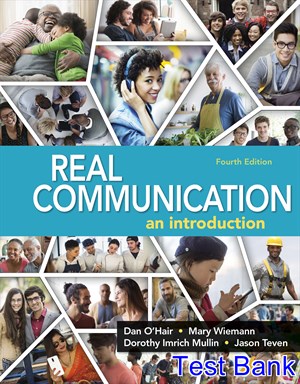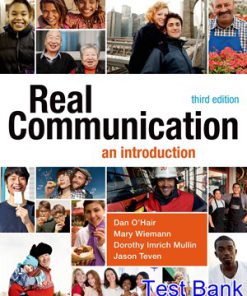Real Communication 4th Edition OHair Test Bank
You may also like
Real Communication 4th Edition OHair Test Bank

Product details:
- ISBN-10 : 131905949X
- ISBN-13 : 978-1319059491
- Author:
Combining stories from actual students with fascinating examples from pop culture and today’s news, Real Communication explains why having versitile communication skills is imperative for successful personal and professional relationships.
Table contents:
Part One. Basic Communication Processes
Chapter 1. Communication: Essential Human Behavior
We Must Communicate: Functions Essential to Living
Expressing Affiliation
Managing Relationships
Influencing Others
Real Communicators: What Job Will You Hold?
How We Communicate
Characteristic of Communication
Assessing Communicative Value
Communicating Competently
Competent Communication is Process-Oriented
Competent Communication is Appropriate and Effective
Competent Communication Involves Ethical Decisions
Competent Communication Involves Communication Skills
Wired for Communication: E-Mail Etiquette: How Not to Communicate with Your Professor
Competent Communication Involves Using Technology
What About You? Assessing Your Competence
Modeling Communication
The Linear Model
The Interaction Model
The Competent Communication Model
Evaluating Communication Ethics: Friends with Money
The Study of Communication
Communication Across Cultures: Judging Sex and Gender
Chapter 2. Communicating in a Digital Age
Digital Origins
Then and Now
What About You? How Attached Are You to Social Media?
Ongoing Dynamic Changes
Qualities of Digital Channels
Evaluating Communication Ethics: The Distracted Notetaker
Synchronicity of Messages
Media Richness and Naturalness
Communication Across Cultures: Mobile Apps Compete for World Influence
Message Privacy and Control
The Power of the Crowd
Information Sharing
Social Support
Social Causes
Real Communicator: Heather Wight
Overcoming Digital Challenges
Digital Disparities
Feeding Insecurities and Obsessions
Wired for Communication: Selfies as Visual Communication, Self-Promotion…and Self-Delusion
Cyber Attacks
REAL REFERENCE: A Study Tool
Chapter 3. Perceiving the Self and Others
Perception: Making Sense of Your World
Schemas: Organizing Perceptions
Attributions: Interpreting Your Perceptions
Improving Your Perceptions
Perception in a Diverse World
The Cultural Context
Communication Across Cultures: Perceptions of Hair Color: A Gray Area
Perceptual Barriers
Cognitions About Ourselves
What About You? Need for Cognition Scale
Self-Concept: Who You Think You Are
Self-Esteem: How You Feel About Yourself
Evaluating Communication Ethics: Ethics and the Self-Concept
Self-Efficacy: Assessing Your Own Abilities
Assessing Our Perceptions of Self
Real Communicator: Lisa M. Turay, CSJ
Behavior: Managing Our Identities
Self-Presentation
Self-Disclosure
Managing Feedback
Technology: Managing the Self and Perceptions
Wired for Communication: Avatars: Virtual Personas and Perception
REAL REFERENCE: A Study Tool
Chapter 4. Verbal Communication
The Nature of Language
Language Is Symbolic
Thought Informs Language
Language Is Ruled by Grammar
The Functions of Language
Using Language as a Means of Control
Using Language to Share Information
Using Language to Express Feelings
Using Language to Express Creativity
Using Language as Ritual
Language and Meaning
Words Have Multiple Meanings
Abstraction
Problematic Uses of Language
Hateful and Hurtful Language
Labeling
Biased Language
Evaluating Communication Ethics: Résumé Language
Profanity and Civility
Language is Bound by Context
Situational Context
Communication Across Cultures: Teaching Twain
Relational Context
Wired for Communication: Speaking in Code
Cultural Context
Real Communicator: Matt Burgess
Mediated Contexts
What About You? Beliefs about “Talk�
REAL REFERENCE: A Study Tool
Chapter 5. Nonverbal Communication
The Nature of Nonverbal Communication
Nonverbal Behavior Is Communicative
Nonverbal Communication Can be Intentional and Unintentional
Nonverbal Communication Is Ambiguous
People Trust Nonverbal Communication More Than Verbal Communication
Functions of Nonverbal Communication
Reinforcing Verbal Messages
Substituting for Verbal Messages
Contradicting Verbal Messages
Managing Impressions and Regulating Interactions
Creating Immediacy
Deceiving Others
What About You? Nonverbal Immediacy Scale
Nonverbal Communication Codes
Gestures and Body Movements
Real Communicator: Octavia Spencer
Facial Expressions
Eye Behavior
Voice
Physical Appearance
Space and Environment
Communication Across Cultures: What Nurses Wear
Evaluating Communication Ethics: The Job Killer Tat
Touch
Time Orientation
Influences on Nonverbal Communication
Culture and Nonverbal Communication
Mediated Nonverbal Communication
Wired for Communication: War Games Without Weapons, Sometimes Without Words
The Situational Context
REAL REFERENCE: A Study Tool
Chapter 6. Communication and Culture
Understanding Culture
Culture Is Learned
Culture Is Expressed Through Communication
Intercultural Communication Matters
Communication and Cultural Variations
High- and Low-Context Cultures
Real Communicator: Vanessa Gonzalez
Collectivist and Individualist Orientations
Comfort with Uncertainty
Masculine and Feminine Orientations
Approaches to Power Distance
Time Orientation
Value of Emotional Expression
What About You? Cultural Values Assessment
Understanding Group Affiliations
Co-Cultural Communication
Social Identity and Intergroup Communication
Wired for Communication: Online Gamers: Women are Hard-core, Too
Communication Across Cultures: The It Gets Better Project
Intercultural Communication Challenges
Anxiety
Ethnocentrism
Discrimination
Improving Intercultural Communication
Mindfulness
Openness to Other Cultures
Effective Intergroup Contact
Appropriate Accommodation
Evaluating Communication Ethics: That’s Not a Soy Substitute
Practice at Using Your Skills
REAL REFERENCE: A Study Tool
Chapter 7. Listening
How We Listen
The Listening Process
Communication Across Cultures: A Quick Lesson in Deaf Etiquette
Listening Goals
What About You? Assess Your Listening Style
The Value of Listening Well
Effective Listening Helps Your Career
Effective Listening Saves Time and Money
Effective Listening Creates Opportunities
Effective Listening Strengthens Relationships
Effective Listening Accomplishes Your Goals
Listening Challenges
Environmental Factors
Biological Factors
Hearing and Processing Challenges
Multitasking
Motivational Factors
Wired for Communication: Don’t Touch That Smartphone
Negative Attitudes About Listening
Real Communicator: Tammy Lin
Unethical Listening
Defensive Listening
Biased Listening
Self-Absorbed Listening
Pseudolistening
Listening Contexts
Evaluating Communication Ethics: Listening When You’re Sick of Hearing
The Relational and Situational Listening Contexts
The Cultural Listening Context
The Technology Listening Context
REAL REFERENCE: A Study Tool
Part Two. Interpersonal Communication
Chapter 8. Developing and Maintaining Relationships
Types of Interpersonal Relationships
Family Relationships
Friendship and Social Relationships
Wired for Communication: Is This Relationship Real?
Romantic Relationships
Online Relationships
Evaluating Communication Ethics: Money, Family, and Paying the Bills
Why We Form Relationships
Proximity
Attractive Qualities
Similarity
Personal and Social Needs
Managing Relationship Dynamics
Costs and Rewards
What About You? Assessing the Costs and Rewards of a Relationship
Reducing Uncertainty
Dialectical Tensions
Self-Disclosure and Interpersonal Relationships
Social Penetration
Managing Privacy
Real Communicator: May Hui
Strategic Topic Avoidance
Stages of a Relationship
Initiating Stage
Exploratory Stage
Intensification Stage
Stable Stage
Declining Stage
Communication Across Cultures: Grieving Relationships
Repair Stage
Termination Stage
Reconciliation
REAL REFERENCE: A Study Tool
Chapter 9. Managing Conflict in Relationships
Understanding Conflict
Unproductive Conflict
Productive Conflict
Conflict Triggers
Inaccurate Perceptions
Incompatible Goals
Relational Transgressions
Provocation
Factors Affecting Conflict
Power Dynamics
Attitudes Toward Conflict
Communication Climate
Culture and Conflict
Communication Channel
Wired for Communication: Locking Down Trolls versus Free Speech
Strategies for Managing Conflict
Escapist Strategies
Communication Across Cultures: Yours, Mine, and Both of Ours
Competitive Strategies
Cooperative Strategies
Evaluating Communication Ethics: The Accidental Relationship Counselor
What About You? Self-Assessment on Conflict Management Styles
Reconciliation
Apology
Forgiveness
Real Communicator: Anonymous
REAL REFERENCE: A Study Tool
Part Three. Group and Organizational Communication
Chapter 10. Communicating in Groups
Understanding Groups
Characteristics of Groups
Types of Groups
Wired for Communication: Smart Mobs: What Flash Mobs and Political Protests Have in Common
Stages of Group Development
Real Communicator: Bambi Francisco Roizen
Complexity of Group Communication
Size of Groups
The Formation of Cliques
Social Loafing
What About You? Are You a “Social Loafer�?
Group Networks
Understanding Group Roles
Task Roles
Social Roles
Antigroup Roles
Role Conflict
Status
Group Climate
Cohesion
Communication Across Cultures: The International American Pastime
Norms
Clarity of Goals
Individual Differences
Evaluating Communication Ethics: Sketchy Behavior
REAL REFERENCE: A Study Tool
Chapter 11. Leadership and Decision Making in Groups
Understanding Group Leadership
Sources of Power
Communication Across Cultures: Gender Judo
Shared Leadership
Group Leadership Behavior
Leadership Qualities
What About You? What Type of Leader Are You?
Evaluating Communication Ethics: Leading the Interns
Unethical Leadership
Culture and Group Leadership
Cultural Variations
Gender and Leadership
Decision Making in Groups
Groupthink
The Problem-Solving Process
Leadership in Meetings
Planning Meetings Effectively
Managing Meetings Effectively
Real Communicator: Aaron Tolson
Using Meeting Technology Effectively
Wired for Communication: Robots are here to stay
Evaluating Group Performance
Informational Considerations
Procedural Effectiveness
Interpersonal Performance
Individual Performance
REAL REFERENCE: A Study Tool
Chapter 12. Communicating in Organizations
Approaches to Managing Organizations
Classical Management Approach
Human Relations Approach
Human Resources Approach
The Systems Approach
Communicating Organizational Culture
Organizational Storytelling
Real Communicator: Kibibi Springs
Learning About Organizational Culture
Relational Contexts in Organizations
Supervisee Relationships
Mentor–Protégé Relationships
Peer Relationships
Evaluating Communication Ethics: More Than Friends at Work
Organizational Challenges
Workplace Conflict
Using Technology
Wired for Communication: Working Here, There, and Everywhere
Globalization
Work–Life Balance
Communication Across Cultures: Work–Life Balance: Around the Globe and Around the Block
Sexual Harassment
What About You? Are You Off Balance?
REAL REFERENCE: A Study Tool
Part Four. Public Speaking
Chapter 13. Preparing and Researching Presentations
The Power of Public Speaking
Clarify the General Purpose of Your Speech
Informative Speeches
Persuasive Speeches
Special-Occasion Speeches
Analyze Your Audience
Considering Audience Expectations and Situational Factors
Considering Audience Demographics and Psychographics Anticipating Your Audience’s Response
What About You? Assessing Your Audience Analysis
Real Communicator: Matt Schermerhorn
Choose Your Topic
Finding a Topic That Intrigues You
Brainstorming and Clustering
Narrowing Your Topic
Determining the Specific Purpose of Your Speech
Developing a Thesis Statement
Research the Topic
Types of Information to Consider
Communication Across Cultures: Human Trafficking: Art, Survival, and Advocacy
Researching Supporting Material
Wired for Communication: The Library in the Sky
Evaluating Supporting Material
Ethical Speaking: Take Responsibility for Your Speech
Recognizing Plagiarism
Taking Accurate Notes
Evaluating Communication Ethics: Didn’t I Already Say That?
Speaking Ethically and Responsibly
REAL REFERENCE: A Study Tool
Chapter 14. Organizing, Writing and Outlining Presentations
Organizing Your Speech Points
Identifying Your Main Points
Supporting Your Main Points
Arranging Your Points
Evaluating Communication Ethics: The Ethics of Using Research
Connecting Your Points
Communication Across Cultures: Evidence, Popular Culture, and the “CSI Effect�
Using Language That Works
Respect Your Audience
Keep It Simple
Use Vivid Language
Incorporate Repetition, Allusion, and Comparisons
Crafting a Strong Introduction
Capture Your Audience’s Attention
Introduce Your Purpose and Thesis
Preview Your Main Points
Connect with Your Audience
Crafting a Strong Conclusion
Signal the End
Reinforce Your Topic, Purpose, and Main Points
Make an Impact
Real Communicator: Mark Weinfeld
Challenge the Audience to Respond
Outlining Your Speech
Wired for Communication: Bullets on the Brain
Essentials of Outlining
Styles of Outlines
From Preparation Outline to Speaking Outline
What About You? Assessing Your Outlining Skills
REAL REFERENCE: A Study Tool
Chapter 15. Delivering Presentations
Understand and Address Anxiety
Identify Anxiety Triggers
What About You? Personal Report of Public Speaking Anxiety
Build Your Confidence
Wired for Communication: Face Your Public Speaking Fears in Virtual Reality
Methods of Delivery
&nb
People also search:
real communication 4th edition
real communication 4th edition pdf free
real communication an introduction 4th edition
real communication an introduction 4th edition pdf
real communication an introduction 4th edition pdf free download












